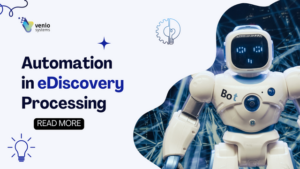
[EDRM is proud to amplify the educational posts of our Trusted Partners.]
Due to the sheer volume of electronic information people and businesses now store, the process of eDiscovery in a legal dispute can involve vast amounts of electronically stored information (ESI). One of the best practices in eDiscovery is using software, including artificial intelligence (AI), to automate various stages of the eDiscovery process. This practice frees up legal teams to focus on strategy and higher-level decisions rather than the minutiae of sorting through ESI.
Venio Systems software can be customized to allow for eDiscovery automation at each step outlined by the Electronic Discovery Reference Model (EDRM), a widely used framework for the eDiscovery process. This blog will give an overview of various opportunities for automation in eDiscovery.
It’s worth mentioning that although an ECA is generally seen as a preliminary step, it does have a ripple effect on different stages of the EDRM. For example, culling a significant number of irrelevant documents during ECA will decrease processing time once that stage is reached.
Team Venio
Automation in ECA
Before proceeding with the first steps of the EDRM, legal teams will engage in an early case assessment (ECA). This process can look different from one legal dispute to another. It essentially consists of uncovering critical ESI and other documentation as early as possible to best determine the parameters of the dispute, including time frames, strategy, and making important decisions like settling or taking a case to court.
An ECA’s goal is to have the best possible understanding of the data set and determine what risks and liabilities might exist in order to guide decisions about the case.
It’s worth mentioning that although an ECA is generally seen as a preliminary step, it does have a ripple effect on different stages of the EDRM. For example, culling a significant number of irrelevant documents during ECA will decrease processing time once that stage is reached.
During ECA, legal teams will want to engage in preliminary data analysis to get some quantitative information — like how much data there actually is — as well as other insights like keywords, date ranges, and names of custodians who might be interviewed. This kind of analysis can then feed automation in eDiscovery software that will sift through ESI rapidly and generate reports about the contents.
Automation at this stage can also include the use of AI. When AI is discussed in the context of the eDiscovery process, it most often refers to predictive coding. This technology is often touted as being most useful during the later review stage of the EDRM, but it can also be used during early case assessment. It consists of training software with existing data, as reviewers tag documents as relevant or irrelevant, and then algorithms take over. With each iteration, the software “learns” to review the ESI and classify documents independently, with minimal human oversight.
During ECA, as the software learns what is relevant to the case, it can also be set to filter out and exclude data and can be used to automate legal holds. Legal holds are an important part of the later stages of the EDRM, including identification, collection, and preservation. As you read on, you’ll learn how Venio’s software can be used to automate such processes.
Read the rest of the post here.

